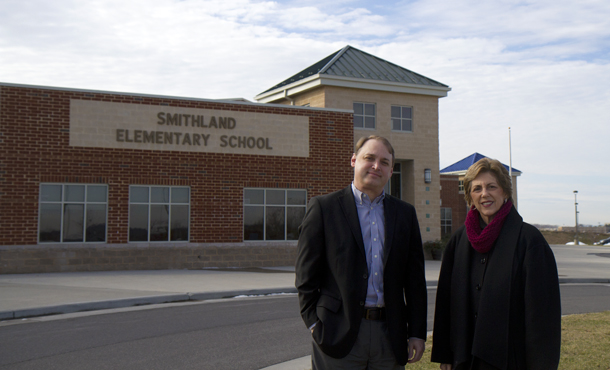The focus on teaching English to non-native speakers in Harrisonburg, Va., began when a ’64 graduate of Eastern Mennonite University (EMU) was tapped to address the needs of the city’s growing group of students who were fluent in other languages, but not English.
This assignment put Linda Heatwole Bland “on the fastest learning curve in my life.” Initially hired as a reading supervisor in 1986, Bland later was assigned to foreign language and English as a second language programs. She found the schools “scrambling” to accommodate the influx of immigrant and refugee families. Knowing no foreign language, she recalls, “I had no experience dealing with it.”
Peers credit Bland, who retired in 2002, with tilling the soil for an innovative dual-language immersion program begun in 2010. At Smithland Elementary, children native to Spanish (the most common language among U.S. immigrants) and those native to English are offered the option of spending each day partly immersed in the other language, with half of their day spent in Spanish and the remainder in English.
From Three-Room Schoolhouse to …
After earning a bachelor’s in elementary education at EMU, Bland taught in her native state of Ohio and West Virginia. Her experiences in a three-room school prompted her to earn a master’s degree in reading at West Virginia University before returning to teach in Virginia and eventually, Harrisonburg.
Bland asked the city’s language teachers for help, promising, “I can coordinate anything, but I will count on you to be the experts in your content. ”
“Linda always made everyone feel special. It was a gift of hers – listening in that way,” says Laura Feichtinger McGrath, Harrisonburg’s current coordinator of English as a Second Language (ESL).
Bland’s lengthening title – “Instructional Supervisor for Reading, English, Language Arts, Foreign Languages and (for the last few years) ESL” – reflected escalating challenges.
Cultural Sensitivity
Early “limited English proficient” children were placed in reading-resource groups, often leaving local children on waiting lists for literacy help. ESL began with just two teachers, division-wide, conducting “pullout” sessions.
Classroom teachers had no training in immigrant children’s needs, said Bland. “Some children arrived highly educated in their native languages; others had never attended school.”
Then-ESL teacher Jeremy Aldrich, now Harrisonburg schools’ foreign language coordinator, remembers Bland “inching us year by year into better instructional practices,” encouraging cultural sensitivity and a welcoming atmosphere for foreign-born students.
Bland recruited dual-language education pioneers Wayne P. Thomas and Virginia P. Collier for teacher and administrator workshops, and cultural anthropologist and local immigration researcher Laura Zarrugh for diversity training.
Zarrugh considers Bland’s work “foundational in establishing the ESL program in city schools and easing the cultural adjustments.”
From Two to 24 Teachers
Bland arranged Spanish classes for teachers and staff, while requesting additional ESL faculty almost yearly. From the original two teachers, their numbers have increased to 24 today. More than a third of the city’s students now are English-language learners.
Meanwhile, Bland recalls, “We began the conversation about a dual-language program, and to explore what it would look like.” In Arlington, Va., “a carload of teachers spent the day” observing dual-language immersion classes. They visited with Arlington’s ESL coordinators, who “just shared everything they knew with us.”
A successful program, they realized, would require a critical mass of bilingual teachers and children. Then-ESL teacher Deanna Benavides, who participated in the visits, remembers that in Harrisonburg, no single school at that time had necessary numbers.
That would change under Wanda Hamilton, who succeeded Bland when she retired in 2002. Smithland’s current principal, Gary Painter, collaborated with Bland and then Hamilton in setting up Harrisonburg’s first dual-language immersion program.
Thriving Dual-Language Immersion
He reports Smithland’s dual-language immersion program continues to expand up and out (adding a grade each year, now serving grades K-2, with hopes to add it in another school in the fall of 2013). For the 2012-2013 school year, Smithland has 120 students in the program.
“The parents and students love it,” Painter said, adding that it has proved to be a painless, fun way for students to acquire a second language.
Meanwhile, since 2011, the Foreign Language in Elementary Schools resource program has given all city children weekly Spanish lessons.
In 2002, Bland received the Virginia State Reading Association’s James D. Mullins Award for exemplary leadership and the Distinguished Service Award of the Shenandoah Valley Virginia Chapter of Pi Delta Kappa.
Bland and husband Sidney Bland, retired from teaching history at James Madison University, live in Massanutten Village east of Harrisonburg. She frequently returns to EMU, serving on the Shenandoah Valley Bach Festival board for 10 years as well as researching her local Heatwole ancestors.
